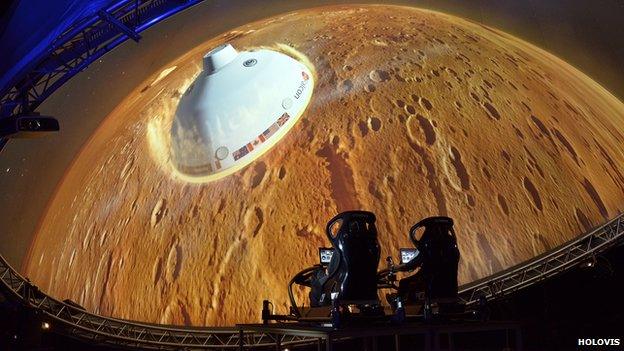Taj Mahal comes to your home as holidays go virtual
- Published
Shilpa Kannan joins in the Google Street View effort at the Taj Mahal
The Taj Mahal - India's most famous and romantic landmark - would be a fitting destination for lovers on Valentine's Day.
But not all of us can afford the air fare. So how about a virtual tour instead?
Google has teamed up with the Indian ministry of culture to bring the Taj Mahal and 99 other heritage sites to Street View.
The 17th Century Taj in Agra, Uttar Pradesh - famous for its gleaming white marble domes and towers and considered to be one of the finest examples of Mughal architecture in the world - is being mapped digitally by Google's backpack Trekker camera.
This portable kit, which enables Google to map places its Street View cars cannot reach, underpins an ambitious project to collect footage of all the world's most treasured natural and man-made landmarks.
It has already been used to map the Grand Canyon and the world's tallest skyscraper, Burj Khalifa, in Dubai.
Suren Ruhela, geo product manager for Google India, told the BBC: "We are creating a digital record of these monuments and those records will live forever.

The virtual tour of the Taj Mahal will give visitors access to parts they cannot get to in real life
"It's not only for this generation but many generations to come. So that's a great way of preserving the culture of the country."
Virtual supplement
The camera constantly takes photos through 15 lenses pointed in different directions. The resulting digital footage is stitched together using software to give viewers a 360-degree image and the feeling that they are walking around the monument or landmark.

The 75 megapixel Trekker cameras have 15 lenses
Not all areas of the vast Taj Mahal complex, seductively set on the banks of the river Yamuna, are open to the public.
But the Trekker will be able to go where tourists cannot, providing a useful virtual supplement to the real-world visits.
The Taj already receives more than 8 million visitors a year, but the Archaeological Survey of India (ASI) - the custodian of all historical sites in the country - hopes this added-value online experience will help attract even more.
"This will benefit the public," says the ASI's Munazzar Ali, a Taj conservationist. "The camera will be allowed inside closed rooms, the entire complex, the tomb in the basement - so people can finally see the Taj like never before."
Google has had a mixed reception in India, sometimes struggling to get permission for its Street View cars to operate, particularly in Bangalore. It also has an Indian street mapping rival called Wonobo, built by Genesys International Corporation.
But Google's Trekker off-road camera is proving less controversial because it has the blessing of India's ASI.
'Internet as memory'
The Taj Mahal project is just one example of how the holiday and tourist industries are using technology to promote and enhance their offerings in an age when about 80% of holidaymakers research their trips online first before making a booking.
UK-based travel operator Thomas Cook, for example, has launched a range of SunConnect hotels featuring ubiquitous wi-fi connectivity and interactive games lounges for teenagers.
"Our holiday market is changing," explains John Straw, chairman of Thomas Cook's advisory board.
"It's all about sharing the experience in real time these days - we're using the internet as our memory. Soon wearable computing will record all our holiday experiences for us almost in real time, so that we can replay them later and relive the whole experience."

Wearable technology like Google Glass will help record our holidays for posterity
Mr Straw envisages Google Glass-like technology featuring facial recognition software becoming embedded into sunglasses, helping holidaymakers see if they have social media friends in common when they're socialising at the hotel bar, for example.
Online virtual tours of hotels and resorts are an increasingly important way holiday companies market their products, he says.
Inner space travel?
Long-haul airlines are increasingly incorporating hi-tech in-flight entertainment systems in their aircraft, such as touchscreen handsets, broadband connectivity, and video-on-demand via HD TV screens.
Futuristic concept planes feature virtual reality screens instead of windows, while space leisure travel draws closer thanks to investment from the likes of Elon Musk's SpaceX company, and Sir Richard Branson's Virgin Galactic.
"At present, leisure space travel is in its infancy, but the history of the travel industry shows that when there exists a clear public appetite for a destination or experience, a combination of technological and entrepreneurial know-how will make it happen," says Victoria Bacon, head of communications for the Association of British Travel Agents (Abta).
But are we getting close to the stage where virtual reality could potentially replace real world holidays altogether?

Immersive 3D technologies like the Holovis MotionDome are making virtual trips possible
"We can supply 360-degree high-definition visuals above and below, smells, sound and heat," says Stuart Hetherington, chief executive of Holovis, an immersive technology specialist.
"We can certainly create the fantasy of sitting on a beach or exploring a jungle."
In future, the walls of our homes could become giant TV screens giving us an extremely vivid 3D "staycation" experience, he believes.
"But I think virtual vacations are still a long way off," he admits.
Ten years from now, it may be possible to manipulate images directly in the brain to create a hyper-realistic virtual experience, he speculates.
But fans of the sci-fi film Total Recall, starring Arnold Schwarzenegger and featuring ill-fated virtual holidays to Mars, may hope that day never dawns.